Wellington Wins Premier Creative Places Award 2001
Other winners: Auckland, Christchurch, Manukau, Central Otago, Waitakere
Wellington City
Council has today won the premier Creative Places Award 2001
for
the exhibition, Parihaka - The Art of Passive
Resistance, held at City Gallery, Wellington from August
2000 to January 2001.
The announcement was made at the Local Government New Zealand Conference in Wellington today where Creative New Zealand Chair, Peter Biggs, spoke to local government representatives about the importance of creativity in our local and national economy.
Creative New Zealand established the annual Creative Places Award in 1999 with the endorsement of Local Government New Zealand. The award is open to all local authorities to enter the innovative arts projects that they have actively supported. This year there were 26 entries.
“The Creative Places Award was set up to recognise and celebrate the outstanding, innovative arts projects currently taking place throughout New Zealand, initiated and supported by local authorities. ” says Elizabeth Kerr, Chief Executive of Creative New Zealand.
This year’s judging panel was Waana Davis, Chair of Toi Maori Aotearoa and former Palmerston North City councillor; Frano Cardno, Mayor of Southland District Council; and Roger King, Director of the Taranaki and Tauranga Arts Festivals.
The judges agreed unanimously that Wellington City Council’s project – Parihaka - The Art of Passive Resistance was the winner of the premier award. The prize is a work of art chosen by the local authority for public display and especially commissioned by Creative New Zealand.
Parihaka was the major millennium project for Wellington City Council and the City Gallery, Wellington in partnership with the people of Parihaka Pa. The exhibition, and the events set up around it, met a number of Wellington City Council’s long-term strategic objectives. It was a groundbreaking, collaborative project for Wellington City Council and the City Gallery, Wellington, working as it did across artforms and political, cultural and community divides.
The exhibition was developed over a seven-year
period, and explored the artistic legacy
of the story of
Parihaka Pâ and its two remarkable leaders – Te Whiti o
Rongomai and Tohu Kâkahi. Wellington City Council provided
a specific budget for the exhibition. Staff from divisions
across the Council contributed to the project and the
Council supplied resources in kind, ensuring the
exhibition’s success.
“The exhibition took a deeply significant look at New Zealand culture and history,” the judges said. “Its impact will continue to be felt far beyond the exhibition. In a very special and arresting way, it challenged people and affected our understanding of our heritage and history. The workshops and performances in the public programme were inclusive and accessible and ensured that the message of Parihaka was broadcast far beyond the walls of the public gallery. The arts content was exceptionally strong, and Wellington City Council’s significant contribution to the project is commendable.”
The premier award winner was chosen from seven category winners, also announced today. Each winner receives a specially commissioned work by well known New Zealand ceramicist, Peter Collis.

1. Arts
Events
Winning Project: Parihaka -The Art of Passive
Resistance
Winning Council: Wellington City
Council
“This project brought together fantastic planning
and an extraordinary working through of the politics
involved,” the judges said. “The exhibition and public
programmes gave true dignity and mana to the stories of
Parihaka and brought the people of Parihaka and the wider
New Zealand community together. The work of Wellington City
Council, with the City Gallery, Wellington and the people of
Parihaka fitted into the Council’s clear plan for arts and
culture.”
Further info: Anne Irving, Publicist, City
Gallery Wellington: 04-801 3959
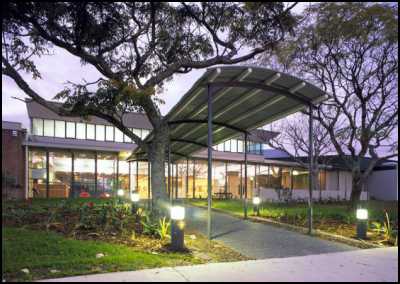
2. Arts Facility
Developments
Winning Project: Te Tuhi – The Mark
Winning Council: Manukau City Council
Te Tuhi – The Mark, the new arts and community complex in Manukau City, was created from the merger of the privately managed Fisher Gallery and the Council-managed Pakuranga Community and Cultural Centre. Since it opened in May 2001, Te Tuhi – The Mark has continued to offer the events and exhibitions both centres were known for. There is also a large multi-purpose foyer area, a new community gallery, a café, shop, meeting room and arts archive/library. The facility is governed by the community-based Pakuranga Arts and Cultural Trust.
“Manukau City has a long history of seeing the arts
as a fundamental aspect of Council strategies,” the judges
said. “This partnership between the independent arts trust,
Manukau City Council and the people of Manukau is
innovative.”
Further info:Yvette Bell, Corporate
Communications Advisor, Manukau City Council:09-262 5187
- 3 -
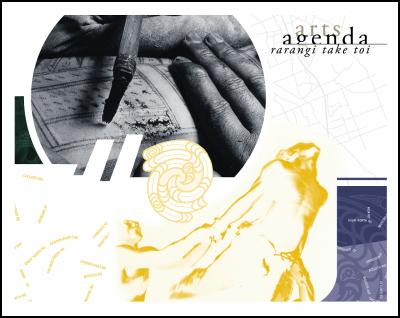
3. Arts Support & Development
Winning Project: Arts Agenda – Rarangi take toi
Winning Council: Auckland City Council
Arts Agenda – Rarangi take toi is the Auckland City Council’s first comprehensive strategy for arts and cultural development in the city. It sets out a vision for the arts in Auckland that sees Auckland as the arts and cultural centre of the Pacific with a unique identity based on Te Ao Maori, its Pacific roots, New Zealand’s natural and cultural heritage, and its cultural diversity. Arts Agenda shows how Auckland City Council can contribute towards achieving this vision over the next five years.
“Arts Agenda is strategic
and visionary. It is the beginning of an exciting future
for Auckland,” the judges said. “By developing art in public
spaces it will strengthen the atmosphere of Auckland
City.”
Further info: Liz Civil, Arts Planner, Auckland
City Council: 09-379 2020

4. Commissions and
Public Art Projects
Winning Project: Manukau Millennium
Sculpture
Winning Council: Manukau City Council
In 1998, Manukau artist Richard Shortland Cooper approached Manukau City Council with a proposal for a millennium sculpture for the city. Because the project supported the City Council’s long-term strategy, it provided both a high-profile site and funds for the project. The remainder of the funding was obtained from the Lottery Grants Board Millennium Fund. The resulting eleven-by-nine metre sculpture was named He Taonga Hiranga Whakanui Whanau – A gift to portray the importance of family.
“The Manukau
sculpture is an imposing artwork reflective of the diversity
of its community,” the judges said. “It is a powerful work
that people can identify and connect with. As it grows in
status as a landmark for Manukau the whole community will
feel proud of it.”
Further info:Yvette Bell, Corporate
Communications Advisor, Manukau City Council:09-262
5187
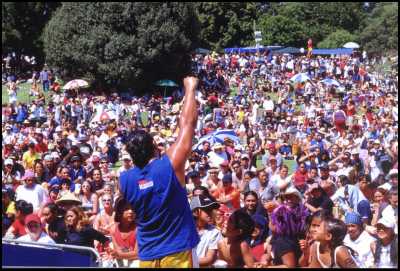
5. Festivals
Winning
Project: Pasifika Festival 2001
Winning Council: Auckland
City Council
The Pasifika Festival, based in the world’s largest Polynesian-populated city, is the largest Pacific Islands community event in the South Pacific. It aims “to develop, promote and celebrate the unity and diversity that is Pasifika”. The one-day Pasifika Festival 2001 entertained 120,000 visitors from the Auckland region and beyond (including from overseas) with performances on four stages, eight cultural villages and 320 stalls.
“This is an
amazing, exciting festival that reflects and celebrates the
cultural diversity of Auckland,” the judges said. “Being
free, it is accessible to many and gives tens of thousands
of people the opportunity to experience performers of a high
calibre.”
Further info: Diane Whisker-Field, Recreation &
Community Services, Auckland City Council: 09-353
9583
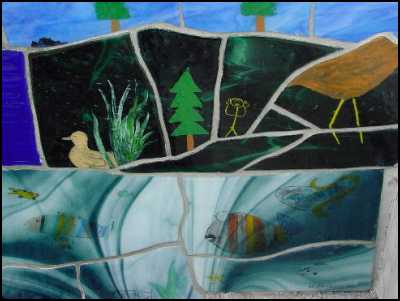
- 4 -
6. Urban and
Landscape Design
Winning Project: Peverel Street – A
Living Street
Winning Council: Christchurch City
Council
‘Living Streets’ are designed or re-designed with
the priority on living and community interaction where
residents, businesses, pedestrians and cyclists have
equality with cars. Peverel Street is Christchurch City
Council’s first Living Street project. Recognizing the
presence of a natural spring
under the street , a water
theme was chosen for the creation of four new features on
the street: a fountain, a viewing window into the
subterranean spring, a footpath based on the meandering of a
braided river and seating well.
“This is a leading-edge
project that has its heart in creating community pride and
ownership, which in turn produces positive behavior,” the
judges said. “The impact on the environment is extremely
positive.” The judges also applauded the high level of
children’s involvement in the project.
Further info: Paul
Burden, City Streets Unit, Christchurch City Council: 03-372
2508
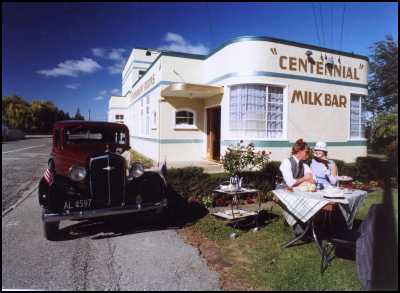
7. Other
Winning
Project: Rural Art Deco Maniototo
Winning
Council: Central Otago District Council
In 1999, the Central Otago District Council’s Economic Development Committee organised a Vision Maniototo workshop to identify economic opportunities for the rural area. From this workshop emerged the concept of Rural Art Deco Maniototo. Its aim was to refurbish the Ranfurly town centre and its art deco buildings, thereby creating a community project and promoting the area as a tourist destination . Within 12 months, 18 buildings have been refurbished and five new businesses have opened. The Rural Art Deco weekend, held in February 2001, was so successful the Council has agreed to make it an annual event.
“This is an example of how
creativity can breed economic development, which is the way
forward for New Zealand,” the judges said. “The community
spirit and generosity is staggering. Over 12,500 hours of
community volunteer time has gone into this project.”
Further info: Sarah Cook, Policy Officer, Central Otago
District Council: 03-448 9924
Judges’ Citation
This year the judges also decided to offer formal
recognition to Waitakere City Council’s outstanding, ongoing
commitment to the arts in the form of a Judges’ Citation
certificate
“for sustained commitment to arts
innovation”. Waitakere City’s Rewarewa Bridge received a
Creative Places Award citation in 1999.
Further
information: Naomi McCleray, Arts Co-ordinator, Waitakere
City Council: 09-836 8000
ex 8550
- Ends -


 Victoria University of Wellington: Dame Winnie Laban Awarded Honorary Doctorate Recognising Achievements For Pasifika
Victoria University of Wellington: Dame Winnie Laban Awarded Honorary Doctorate Recognising Achievements For Pasifika  HESSA: This Isn’t Fair—And It’s Time To Fix It - HESSA Petition Calls For Inclusive Student Sports
HESSA: This Isn’t Fair—And It’s Time To Fix It - HESSA Petition Calls For Inclusive Student Sports Post Primary Teachers' Association: PPTA Calls On Minister Stanford To Come Clean On Kāhui Ako
Post Primary Teachers' Association: PPTA Calls On Minister Stanford To Come Clean On Kāhui Ako  Arts Access Aotearoa: Kim Anderson Awarded Deaf And Disabled Artists Fellowship 2025
Arts Access Aotearoa: Kim Anderson Awarded Deaf And Disabled Artists Fellowship 2025 Oratia Books: New Bilingual Picture Book Of Samoan Proverbs In Time For Samoa Language Week 2025
Oratia Books: New Bilingual Picture Book Of Samoan Proverbs In Time For Samoa Language Week 2025 Headway: Run It Straight
Headway: Run It Straight